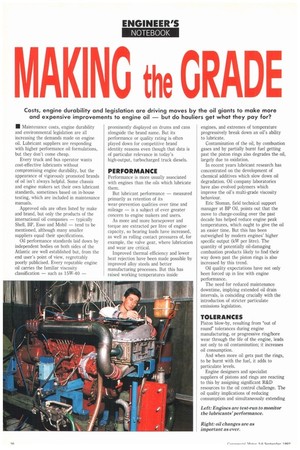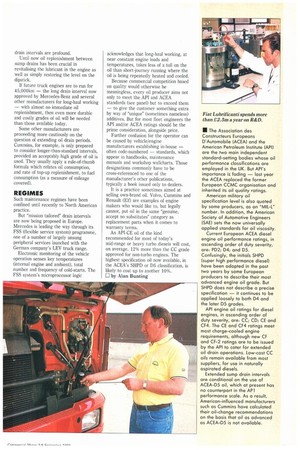MAKING the GRADE Costs, engine durability and legislation are driving
Page 38

Page 39

If you've noticed an error in this article please click here to report it so we can fix it.
moves by the oil giants to make more and expensive improvements to engine oil — but do hauliers get what they pay for?
Mi Maintenance costs, engine durability and environmental legislation are all increasing the demands made on engine oil. Lubricant suppliers are responding with higher performance oil formulations, but they don't come cheap.
Every truck and bus operator wants cost-effective lubricants without compromising engine durability, but the appearance of vigorously promoted brands of oil isn't always helpful. Some chassis and engine makers set their own lubricant standards, sometimes based on in-house testing, which are included in maintenance manuals.
Approved oils are often listed by make and brand, but only the products of the international oil companies — typically Shell, BP, Esso and Mobil — tend to be mentioned, although many smaller suppliers equal their specifications.
Oil performance standards laid down by independent bodies on both sides of the Atlantic are well established but, from the end user's point of view, regrettably poorly publicised. Every reputable engine oil carries the familiar viscosity classification — such as 15W-40 — prominently displayed on drums and cans alongside the brand name. But its performance or quality rating is often played down for competitive brand identity reasons even though that data is of particular relevance in today's high-output, turbocharged truck diesels.
PERFORMANCE
Performance is more usually associated with engines than the oils which lubricate them.
But lubricant performance — measured primarily as retention of its wear-prevention qualities over time and mileage — is a subject of ever greater concern to engine makers and users.
As more and more horsepower and torque are extracted per litre of engine capacity, so bearing loads have increased, as well as rolling contact pressures of, for example, the valve gear, where lubrication and wear are critical.
Improved thermal efficiency and lower heat rejection have been made possible by improved alloy steels and better manufacturing processes. But this has raised working temperatures inside engines, and extremes of temperature progressively break down an oil's ability to lubricate.
Contamination of the oil, by combustion gases and by partially burnt fuel getting past the piston rings also degrades the oil, largely due to oxidation.
In recent years lubricant research has concentrated on the development of chemical additives which slow down oil degradation. Oil company laboratories have also evolved polymers which improve the oil's multi-grade viscosity behaviour.
Eric Sloman, field technical support manager at BP Oil, points out that the move to charge-cooling over the past decade has helped reduce engine peak temperatures, which ought to give the oil an easier time. But this has been outweighed by modern engines' higher specific output (kW per litre). The quantity of potentially oil-damaging combustion products likely to find their way down past the piston rings is also increased by this trend.
Oil quality expectations have not only been forced up in line with engine performance.
The need for reduced maintenance downtime, implying extended oil drain intervals, is coinciding crucially with the introduction of stricter particulate emissions legislation.
TOLERANCES
Piston blow-by, resulting from gout of round" tolerances during engine manufacturing, or progressive ring/bore wear through the life of the engine, leads not only to oil contamination; it increases oil consumption.
And when more oil gets past the rings, to be burnt with the fuel, it adds to particulate levels.
Engine designers and specialist suppliers of pistons and rings are reacting to this by assigning significant R&D resources to the oil control challenge. The oil quality implications of reducing consumption and simultaneously extending drain intervals are profound.
Until now oil replenishment between sump drains has been crucial in revitalising the lubricant in the engine as well as simply restoring the level on the dipstick.
If future truck engines are to run for 45,000km — the long drain interval now approved by Mercedes-Benz and several other manufacturers for long-haul working — with almost no immediate oil replenishment, then even more durable and costly grades of oil will be needed than those available today.
Some other manufacturers are proceeding more cautiously on the question of extending oil drain periods. Cummins, for example, is only prepared to consider longer-than-standard intervals, provided an acceptably high grade of oil is used. They usually apply a rule-of-thumb formula which relates oil consumption, and rate of top-up replenishment, to fuel consumption (as a measure of mileage covered).
REGIMES
Such maintenance regimes have been confined until recently to North American practice.
But "mission tailored" drain intervals are now being proposed in Europe. Mercedes is leading the way through its FSS (flexible service system) programme, one of a number of largely unsung peripheral services launched with the German company's LEV truck range.
Electronic monitoring of the vehicle operation senses key temperatures (internal engine and ambient), total number and frequency of cold-starts. The FSS system's microprocessor logic acknowledges that long-haul working, at near constant engine loads and temperatures, takes less of a toll on the oil than short-journey running where the oil is being repeatedly heated and cooled.
Because commercial competition based on quality would otherwise be meaningless, every oil producer aims not only to meet the API and ACEA standards (see panel) but to exceed them — to give the customer something extra by way of "unique" (sometimes nameless) additives. But for most fleet engineers the API and/or ACEA ratings should be the prime consideration, alongside price.
Further confusion for the operator can be caused by vehicle/engine manufacturers establishing in-house — often code-numbered — standards, which appear in handbooks, maintenance manuals and workshop wallcharts. Those designations commonly have to be cross-referenced to one of the manufacturer's other publications, typically a book issued only to dealers.
It is a practice sometimes aimed at selling own-brand oil. Volvo, Cummins and Renault (Elf) are examples of engine makers who would like to, but legally cannot, put oil in the same "genuine, accept no substitutes" category as replacement parts when it comes to warranty terms.
An API-CE oil of the kind recommended for most of today's mid-range or heavy turbo diesels will cost, on average, 12% more than the CC grade approved for non-turbo engines. The highest specification oil now available, in the ACEA's SHPD or D5 classification, is likely to cost up to another 10%.
El by Alan Bunting




































































































